When you think of the Cotswolds you probably picture gentle rolling countryside littered with idyllic villages full of charming period cottages; an ideal place for a relaxing retreat. Well, one couple decided to build a property that pushed the boundaries of what contemporary Cotswold living could be, offering all the perks of the gorgeous surrounding countryside while being a stunning modern house with spectacular eco credentials. This is the story of how Moonstone came to be.
The initial concept
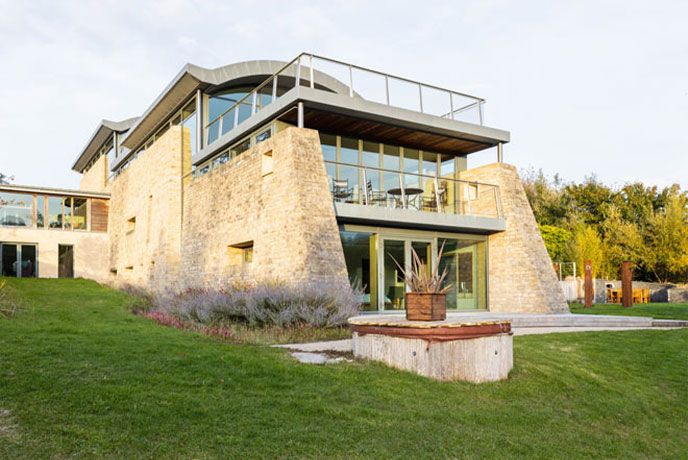 After being offered a plot of land just outside of Cheltenham in 2003 with a notoriously unreliable planning permission history, the owners decided now was the time to build a zero-carbon footprint eco house in the Cotswolds capable of being completely autonomous.
After being offered a plot of land just outside of Cheltenham in 2003 with a notoriously unreliable planning permission history, the owners decided now was the time to build a zero-carbon footprint eco house in the Cotswolds capable of being completely autonomous.
Their aim was “To design an architecturally outstanding Cotswold contemporary stone home in harmony with its setting, in scale with its surroundings and to positively impact this Area of Outstanding Natural Beauty”
The project was named Moonstone, after the birthstone of the owner which radiates inner growth, strength and big-picture thinking, and work started on trying to figure out how such a build could be achieved. They hired architect Mike Hope and together with John’s experience as a skilled builder, they worked together on devising plans for this spectacular house.
Realising the vision
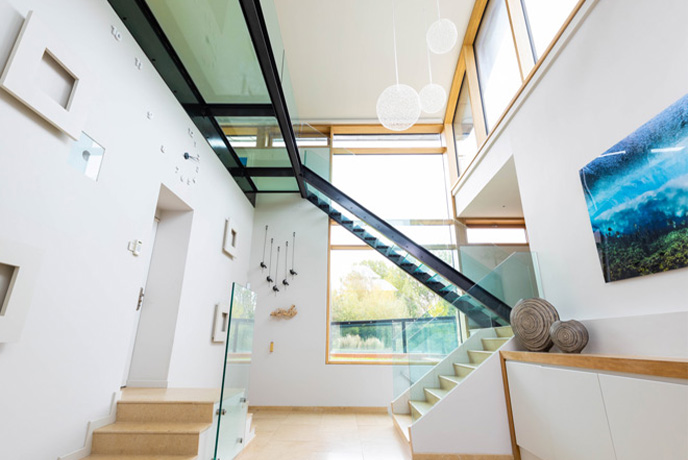 The original concept for the house was denied planning permission from the planning committee due to its massive scale. However, after changes to the design were made to make the structure more sympathetic to the surrounding landscape, the owners were given the go-ahead to start work on their dream home. They began by dismantling the old timber cottage that once belonged to the site, ensuring to keep as many materials as possible to reuse. They then excavated the site, and in doing so they stumbled across an abundance of gorgeous Cotswold stone which was kept and eventually used as the filler for the Stone walls that surround Moonstone.
The original concept for the house was denied planning permission from the planning committee due to its massive scale. However, after changes to the design were made to make the structure more sympathetic to the surrounding landscape, the owners were given the go-ahead to start work on their dream home. They began by dismantling the old timber cottage that once belonged to the site, ensuring to keep as many materials as possible to reuse. They then excavated the site, and in doing so they stumbled across an abundance of gorgeous Cotswold stone which was kept and eventually used as the filler for the Stone walls that surround Moonstone.
During construction, the owners and their architect visited a house with similar aspects to their design in Oxford. The visit inspired them to adopt a number of insulation and heat-saving techniques they had not previously included in their original design such as a clever heat recovery earth pipe system.
Eco aspects
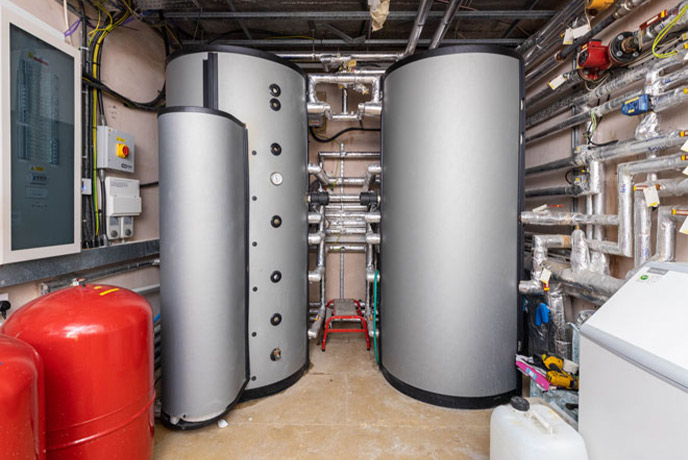 The earth pipes were added to a long list of fantastic eco-friendly credentials. Architect Mike Hope was keen to design the house in a way that concealed the eco features so as to not take away from the beauty of the majestic structure. A vast array of insulation was integrated into the walls throughout the build to enable the house to be as efficient as possible in a passive state. Quadlock insulation bricks were used in the basement while nearly half a meter of insulation can be found in the walls of the upper floors. An airtight rubber membrane and triple-glazed windows were also fitted to add to Moonstone’s incredible insulation qualities.
The earth pipes were added to a long list of fantastic eco-friendly credentials. Architect Mike Hope was keen to design the house in a way that concealed the eco features so as to not take away from the beauty of the majestic structure. A vast array of insulation was integrated into the walls throughout the build to enable the house to be as efficient as possible in a passive state. Quadlock insulation bricks were used in the basement while nearly half a meter of insulation can be found in the walls of the upper floors. An airtight rubber membrane and triple-glazed windows were also fitted to add to Moonstone’s incredible insulation qualities.
44 square meters of solar panels then work in tandem with two hot water storage tanks to keep the house nice and toasty with 92% of the heating and hot water coming from solar energy. A backup ground source heat pump was also fitted for emergencies but is hardly ever used due to the incredible efficiency of the house.
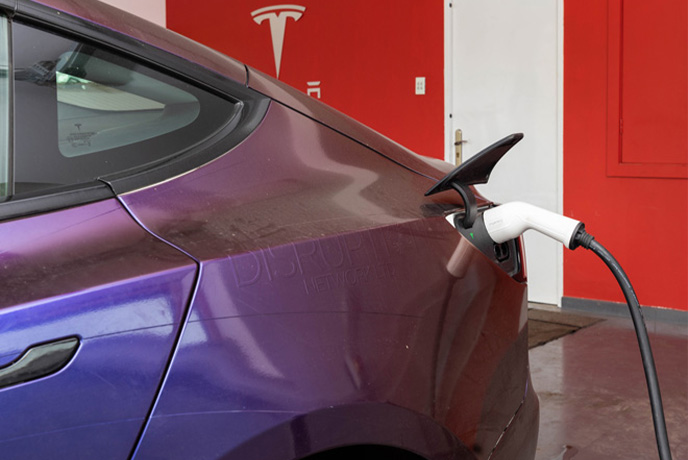 60 meters worth of heat recovery earth pipes are buried underground to reheat any of the cold air leaving the house in the winter while also providing a source of cool air in the summer.
60 meters worth of heat recovery earth pipes are buried underground to reheat any of the cold air leaving the house in the winter while also providing a source of cool air in the summer.
A zinc-topped curved roof and ingenious gull wings collect plenty of rainwater along with cleaver drainage around the house and along the drive. All this water is then sent directly into a 10,000-litre water collection tank which is then fed into the hot water storage tanks. Additionally, Reed beds purify any of the house’s black water to drinking level which is then either sent back up to the water tank or fed into the River Churn which runs alongside the house.
Landscaping and design
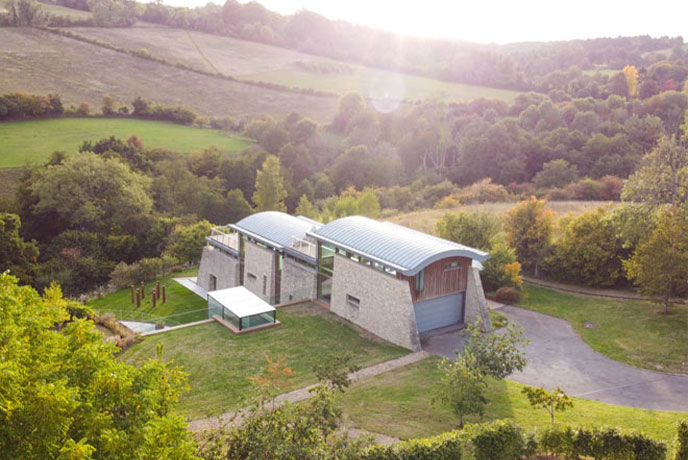 The look of the house ended up being a major factor in achieving planning permission for the mammoth build and there are many fabulous design ques dotted around the house which wonderfully complement its gorgeous Cotswold surroundings. Moonstone incorporates a curved zinc roof which contributes to the house’s water collection but is also designed to reflect the Dutch barn roofs littered across Cotswold gentle farmland. Slot windows were also used to reinforce the Cotswold nature of the house.
The look of the house ended up being a major factor in achieving planning permission for the mammoth build and there are many fabulous design ques dotted around the house which wonderfully complement its gorgeous Cotswold surroundings. Moonstone incorporates a curved zinc roof which contributes to the house’s water collection but is also designed to reflect the Dutch barn roofs littered across Cotswold gentle farmland. Slot windows were also used to reinforce the Cotswold nature of the house.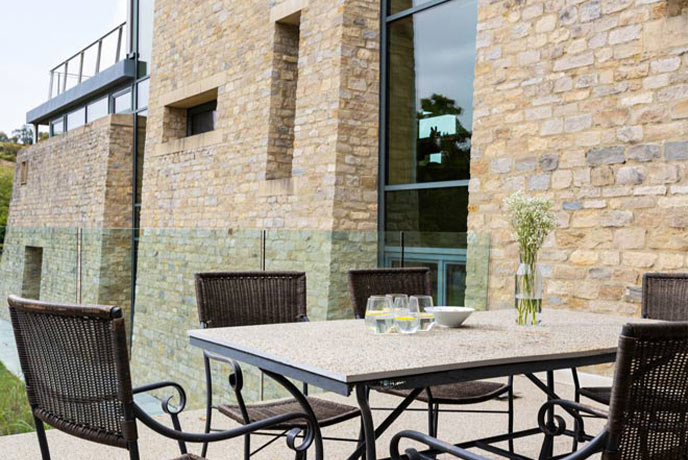 Gorgeous Cotswold stone was sourced from a quarry four miles down to road to act as the charming exterior of the building with a team of three stonemasons crafting the beautiful walls by hand using the rich material. Finally, almost a third of Moonstone sits underground and is coved up by a brilliantly landscaped site.
Gorgeous Cotswold stone was sourced from a quarry four miles down to road to act as the charming exterior of the building with a team of three stonemasons crafting the beautiful walls by hand using the rich material. Finally, almost a third of Moonstone sits underground and is coved up by a brilliantly landscaped site.
The finished house
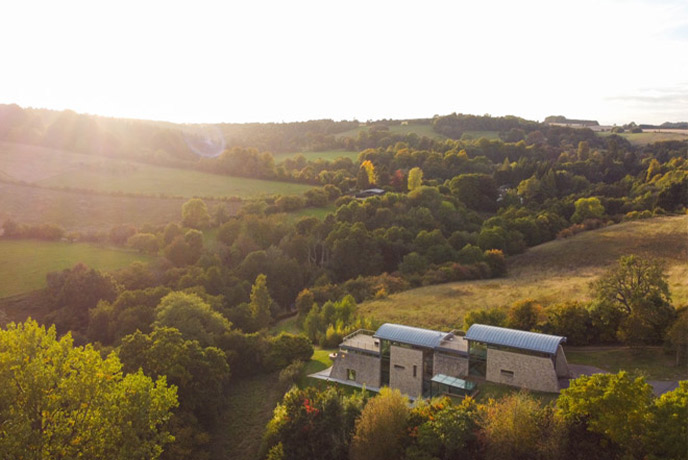 After plenty of ups and downs and nearly five years of work, Moonstone was finally finished, and the majestic house clad in beautiful Cotswold stone now sits proudly overlooking the River Churn quietly working as one of the most efficient eco-friendly houses in the U.K. All that hard work from the owners paid off and we asked them what their favourite parts of the house were:
After plenty of ups and downs and nearly five years of work, Moonstone was finally finished, and the majestic house clad in beautiful Cotswold stone now sits proudly overlooking the River Churn quietly working as one of the most efficient eco-friendly houses in the U.K. All that hard work from the owners paid off and we asked them what their favourite parts of the house were:
“We love to make a cup of tea and sit on the balcony or by the window watching the weather and clouds roll by, spotting the heron fishing on the pond, birds and night sky. The piano lounge and balcony are also perfect for curling up with a book and a cuppa.
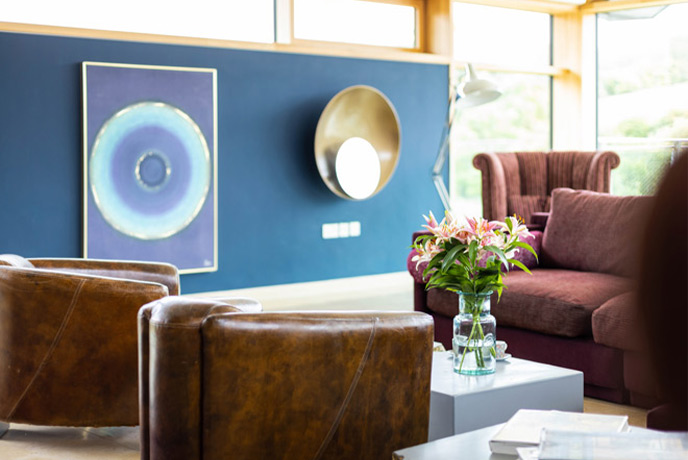 We love visiting the quintessential villages and towns of the Cotswolds, Bibury, Bourton on the Water and Burford, taking in a lovely dog walk along the Cotswolds Way and stopping at a Cotswold country pub for lunch, Gloucester old spot sausage and mash, local Woodchester wine or Old Hookey beer, followed by some local cheeses.”
We love visiting the quintessential villages and towns of the Cotswolds, Bibury, Bourton on the Water and Burford, taking in a lovely dog walk along the Cotswolds Way and stopping at a Cotswold country pub for lunch, Gloucester old spot sausage and mash, local Woodchester wine or Old Hookey beer, followed by some local cheeses.”
If you want the chance to stay at this spectacular and wonderfully unique property you can book your stay at Moonstone here and enjoy the luxuries of this marvellous Cotswold eco-house.

